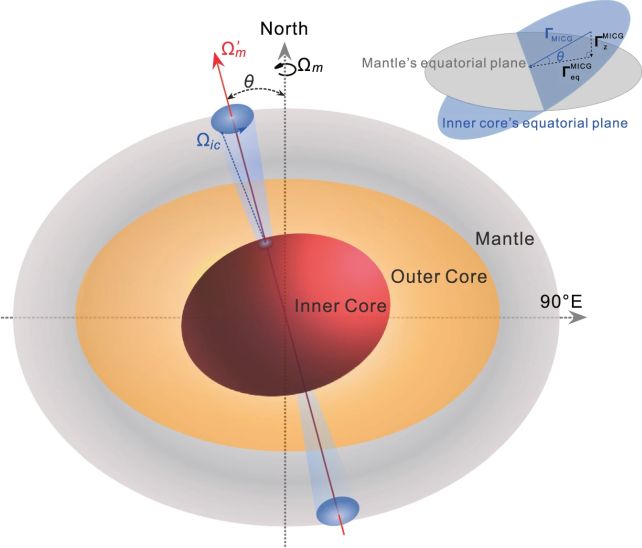Strange variations across different measurements of the planet's surface have revealed periodic oscillations deep in Earth's heart.
By studying minute changes in the length of Earth's day and the motion of Earth's poles, a team led by geoscientists Yachong An and Hao Ding of Wuhan University have determined that Earth's inner core wobbles with a periodicity of 8.5 years.
This, in turn, has revealed a tilt between the inner core and the mantle of just 0.17 degrees, suggesting that Earth's inner core is denser in the northwestern hemisphere – a strange phenomenon that we've seen hints of in seismological data.
The discovery could be a game-changer for the way we understand the inner workings of our world. Some geodynamics research assumes a much larger tilt, around 10 degrees; the new measurement gives us a new tool for interpreting surface manifestations of behavior at the planet's core.
Earth's interior is full of activity that we barely understand. We know that our planet is layered, like a jawbreaker or spherical layer cake; and that, towards the center, it churns and roils with molten rock and metal that gets denser and heavier the deeper you go.
At the center is the core, a sphere of molten metal; and in the center of the core is the inner core, a hot, dense ball of solid iron around 2,450 kilometers (1,520 miles) across, a little bigger than the size of Pluto.

The inner core is the heart of our planet in more ways than one. As it slowly cools and grows, it releases heat, which is thought to contribute significantly to the dynamo that swirls in the outer core.
This is the rotating, convecting, conducting fluid that converts mechanical energy into magnetic energy, generating the magnetic field that protects our planet from radiation, atmospheric escape, and the solar wind.
So scientists are pretty interested in the core, the inner core, and all the little quirks and anomalies that could have an effect on us little humans scurrying about on the surface.
Since we can't go down there to measure it directly, we have to rely on indirect measurements, based on things we can observe at the surface.
We tend to think of the rotation period as fixed, with our planet completing a full spin once every 23 hours, 56 minutes, and 4.0916 seconds each and every day of the year.
But there are actually really small variations generated by shifts that happen inside the planet. For example, research published last year found that Earth's core changes the direction of its rotation every six years or so, manifesting as a change in the length of the day.

In 2019, a team of scientists led by Ding noticed a different periodicity in the way Earth's poles move. Earth's poles are always moving in very pronounced ways, and there are several different reasons for that, resulting in some pretty strange behavior.
But in 2019, Ding and co. noticed a small, roughly 8.7-year motion that they thought could represent a wobble in Earth's inner core.
An and Ding followed up this discovery by looking for changes in Earth's rotation that supported the same periodicity. And they found it. By carefully measuring each signal, they were able to map the inner core traits that would produce these phenomena.
The inner core, they found, is tilted with respect to Earth's mantle by 0.17 degrees. In other words, the rotational axis of the inner core and the rotational axis of the mantle are not quite aligned. This produces a 'wobble' they calculate to be closer to 8.5 years, as the two spheres rotate around slightly different axes.
The measured signals are also consistent with a sharper than expected change in density at the boundary between the inner core and the outer core. And the inner core seems to have inhomogeneous density, with one hemisphere being denser than the other.
These characteristics could play a role in the way the fluid outer core churns and rotates, and thus generates Earth's magnetic field.
There does, however, seem to be rather a lot more going on in our planetary core than we currently comprehend. As our instrumentation and techniques improve, all we can do is keep studying the strange effects that hidden activity has on the world's exterior.
The research has been published in Nature Communications.
